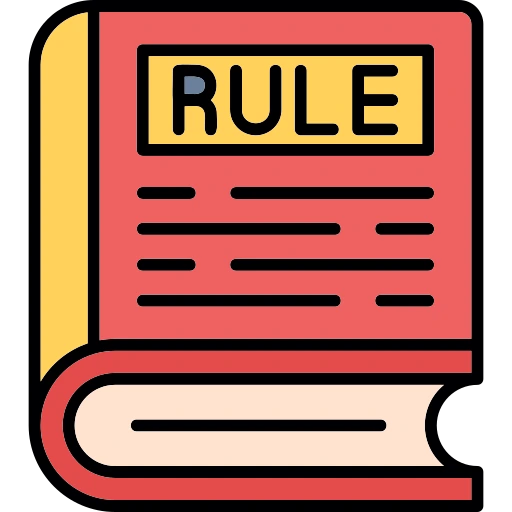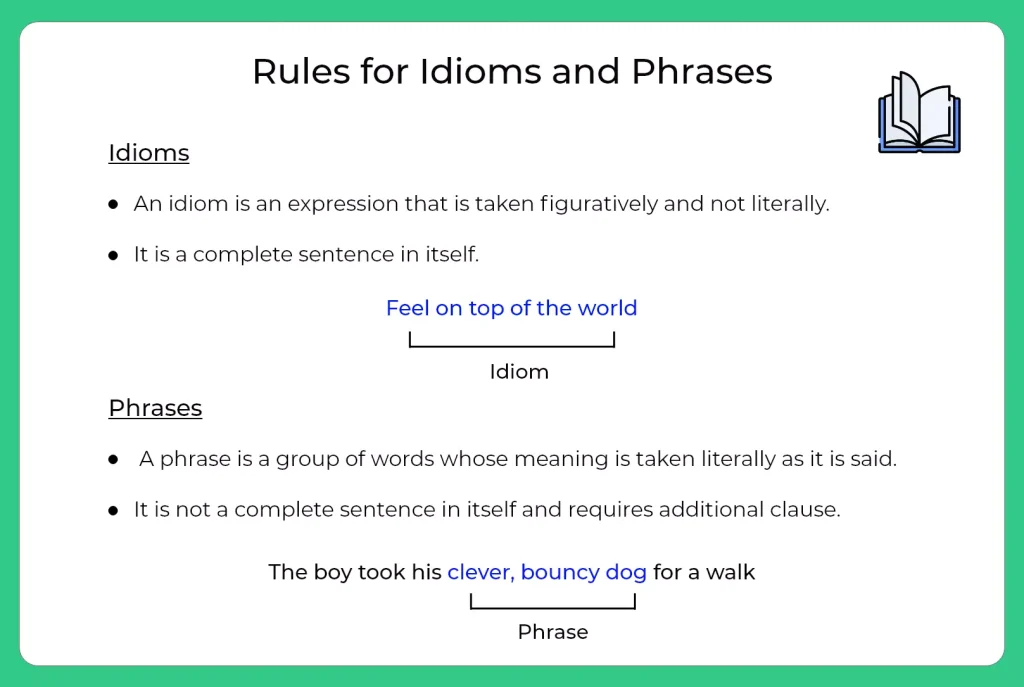Verbal Menu
- Basic Grammar
- Speech and Voices
- Tenses
- Articles
- Tenses and Articles
- Idioms and Phrases
- Subject Verb Agreement
- Prepositions and Conjunction
- Selecting Words
- Relative Pronoun
- Sentence Completion
- Sentence Ordering
- Contextual Vocabulary
- Jumbled Sentence
- Sentence Formation
- Error Identification
- Sentence Improvement and Construction
- Cloze Test
- Fill in the blanks
- Paragraph Ordering
- Para Jumbles
- Synonyms and Antonyms
- Synonyms
- Antonyms
- Reading Comprehension
- Get Off-campus Drive Updates
- Get Hiring Updates
- Contact US
PREPINSTA PRIME
Rules For Idioms And Phrases
The Idioms and Phrases rules is most commonly the same to understand.
Idioms generally demonstrate behavior of human, reaction to certain thing, habits and traditions. An, idiom is a set of certain words which when used together, brings out a meaning which is entirely different from the meaning of each word when it is used individually.
Idioms and Phrases Rules
The Idioms and Phrases rules is most commonly the same to understand.
Idioms generally demonstrate behavior of human, reaction to certain thing, habits and traditions. An, idiom is a set of certain words which when used together, brings out a meaning which is entirely different from the meaning of each word when it is used individually.


Idioms And Phrases Rules
Idioms and Phrases are literal terms that induce a meaning that may be otherwise hidden behind the actual words.
- They have a cultural value attached to themselves.
- They are metaphorical in the sense that if you extract the literal meaning of all the words stated then it would be too unusual to believe or even farcical.
- Idioms and phrases have the capacity to add a flavor to a boring prose or book and are used by authors to add something interesting or remove monotones from their writing.
While reading and answering Idioms and Phrases we can say that there is a slight difference in the two.

While a phrase is a small group of words that have a meaning when taken together.
Let’s now see some examples of both the sections below:
Idioms
For example:
- Being comfortable in one’s skin –
If you take the literal meaning it would be absurd to even explain.
However the actual meaning here that we can extract : ‘the feeling of being comfortable with yourself’.
One’s skin means own skin or to simplify ‘yourself’ - Beat around the bush –
With this idiom it doesn’t mean to actually take a bat and beat the bush but:
to talk about everything around the topic and try to ignore / avoid the main topic, the person, or a particular thing.
Phrases
For Example:
- Deep down – deeper feelings
- Group of men and women – group of men and group of women
- Challenge of imagination – challenging to be imaginative
- Latin and Greek – some strange meaning
Prime Course Trailer
Related Banners
Get PrepInsta Prime & get Access to all 200+ courses offered by PrepInsta in One Subscription
Rules for Idioms and Phrases
- Understand the Contextual Meaning:
Idioms often have meanings that are not obvious from the individual words. Always try to understand the overall meaning in context rather than interpreting them literally. - Use the Exact Wording:
Idioms are fixed expressions. You cannot change the words or structure. Even minor alterations can result in incorrect or awkward usage. - Appropriate Usage Based on Situation:
Idioms should be used carefully depending on the situation. While they add expression to informal communication, they should be avoided in highly formal or academic writing unless specifically required. - Learn by Category:
Group idioms based on themes such as emotions, actions, success, or relationships. Learning them in sets helps with memorization and understanding. - Practice with Full Sentences:
Always study idioms within full sentences rather than learning them in isolation. This improves comprehension and usage. - Be Aware of Similar Idioms:
Some idioms may look or sound similar but have completely different meanings. Do not confuse them. Learning them carefully helps avoid mistakes. - Avoid Overuse:
Using too many idioms in your writing or speech can make it sound unnatural. Use them moderately and only when they enhance clarity or expression. - Don’t Translate Literally:
Idioms should never be translated word-for-word from one language to another. Their meanings are cultural and based on usage, not literal definitions. - Regular Revision is Essential:
To retain idioms effectively, regular revision is important. Practice through reading, writing, and mock tests for better recall during exams. - Refer to Trusted Sources:
Always rely on authentic sources or dictionaries for meanings and usage. Avoid using idioms based only on assumptions or incorrect interpretations.
Common Mistakes to Avoid
- Changing the Words in an Idiom:
Idioms are fixed expressions. Modifying any word can make the idiom incorrect or meaningless. - Using Idioms Out of Context:
Idioms must be used in appropriate situations. Using them without understanding the context can lead to confusion. - Translating Idioms Literally:
Idioms do not carry their literal meaning. Attempting to understand or explain them word-for-word often results in misunderstanding. - Mixing Two Idioms Together:
Combining parts of different idioms creates incorrect expressions that are grammatically and contextually wrong. - Overusing Idioms in Formal Writing:
Idioms should be used sparingly in professional or academic writing. Excessive use can make the writing appear casual or unclear. - Assuming the Meaning Without Verification:
Relying on guesswork or intuition can lead to incorrect usage. Always confirm the meaning of an idiom from a reliable source. - Ignoring Grammar Rules:
Idioms must still follow basic grammar rules when placed in a sentence. Tense, agreement, and sentence structure must remain correct. - Learning Idioms in Isolation:
Studying idioms without understanding how they function in sentences can reduce clarity and hinder practical usage.
Also Check Out
Also Check:
- Basic Grammar – Questions | Rules | How to Solve Quickly | Tricks & Shortcuts
- Speech and Voices – Questions | Rules | How to Solve Quickly | Tricks & Shortcuts
- Tenses – Questions | Rules | How to Solve Quickly | Tricks & Shortcuts
- Tenses and Articles – Questions | Rules | How to Solve Quickly | Tricks & Shortcuts
- Idioms and Phrases – Questions | Rules | How to Solve Quickly | Tricks & Shortcuts
- Subject Verb Agreement – Questions | Rules | How to Solve Quickly | Tricks & Shortcuts
- Prepositions and Conjunction – Questions | Rules | How to Solve Quickly | Tricks & Shortcuts
- Selecting Words – Questions | Rules | How to Solve Quickly | Tricks & Shortcuts
- Relative Pronoun – Questions | Rules | How to Solve Quickly | Tricks & Shortcuts
- Sentence Completion- Questions | Rules | How to Solve Quickly | Tricks & Shortcuts
- Basic Grammar
Questions
Rules
How to Solve Quickly
Tricks & Shortcuts - Speech and Voices
Questions
Rules
How to Solve Quickly
Tricks & Shortcuts - Tenses
Questions
Rules
How to Solve Quickly
Tricks & Shortcuts - Tenses and Articles
Questions
Rules
How to Solve Quickly
Tricks & Shortcuts - Idioms and Phrases
Questions
Rules
How to Solve Quickly
Tricks & Shortcuts - Subject Verb Agreement
Questions
Rules
How to Solve Quickly
Tricks & Shortcuts - Prepositions and Conjunction
Questions
Rules
How to Solve Quickly
Tricks & Shortcuts - Selecting Words
Questions
Rules
How to Solve Quickly
Tricks & Shortcuts - Relative Pronoun
Questions
Rules
How to Solve Quickly
Tricks & Shortcuts - Sentence Completion
Questions
Rules
How to Solve Quickly
Tricks & Shortcuts
Get over 200+ course One Subscription
Courses like AI/ML, Cloud Computing, Ethical Hacking, C, C++, Java, Python, DSA (All Languages), Competitive Coding (All Languages), TCS, Infosys, Wipro, Amazon, DBMS, SQL and others

 Apply For Jobs
Apply For Jobs Get Hiring Updates
Get Hiring Updates




Login/Signup to comment